Recycled Construction and Demolition Waste as Supplementary Cementing Materials in Eco-Friendly Concrete
Abstract
1. Introduction
2. Results and Discussions
2.1. Pozzolanicity and Hydration
2.2. Fresh Properties, Mechanical Properties and Transport Mechanisms of Concrete
3. Materials and Methods
3.1. Pozzolanicity and Hydration
3.2. Fresh Properties, Mechanical Properties, and Transport Mechanisms of Concretes
4. Conclusions
5. Limitations and Recommendations for Further Studies
Author Contributions
Funding
Data Availability Statement
Acknowledgments
Conflicts of Interest
References
- Tam, V.W.; Tam, C.M. A review on the viable technology for construction waste recycling. Resour. Conserv. Recycl. 2006, 47, 209–221. [Google Scholar] [CrossRef]
- Rosa, J.; Pastó, E. Gestión de escombros y otros residuos de la construcción. Rev. Ambiente 2004, 24, 53–56. [Google Scholar]
- Organisation for Economic Co-Operation and Development (OECD). Towards a More Resource-Efficient and Circular Economy: The Role of the G20; OECD: Paris, France, 2021.
- López Ruiz, L.A.; Roca Ramón, X.; Gassó Domingo, S. Economía circular en el sector de los residuos de construcción y demolición: Análisis de iniciativas en España. In Proceedings of the 24th International Congress on Project Management and Engineering, Alcoy, Spain, 7–9 July 2020; pp. 1320–1334. [Google Scholar]
- Akhtar, A.; Sarmah, A.K. Construction and demolition waste generation and properties of recycled aggregate concrete: A global perspective. J. Clean. Prod. 2018, 186, 262–281. [Google Scholar] [CrossRef]
- Seror, N.; Portnov, B.A. Estimating the effectiveness of different environmental law enforcement policies on illegal C&D waste dumping in Israel. Waste Manag. 2020, 102, 241–248. [Google Scholar] [CrossRef]
- Xiao, J.; Ma, Z.; Ding, T. Reclamation chain of waste concrete: A case study of Shanghai. Waste Manag. 2016, 48, 334–343. [Google Scholar] [CrossRef] [PubMed]
- Yang, D.; Liu, M.; Ma, Z. Properties of the foam concrete containing waste brick powder derived from construction and demolition waste. J. Build. Eng. 2020, 32, 101509. [Google Scholar] [CrossRef]
- Shooshtarian, S.; Caldera, S.; Maqsood, T.; Ryley, T. Using recycled construction and demolition waste products: A review of stakeholders’ perceptions, decisions, and motivations. Recycling 2020, 5, 31. [Google Scholar] [CrossRef]
- Guo, H.; Shi, C.; Guan, X.; Zhu, J.; Ding, Y.; Ling, T.C.; Wang, Y. Durability of recycled aggregate concrete—A review. Cem. Concr. Compos. 2018, 89, 251–259. [Google Scholar] [CrossRef]
- Liang, C.; Ma, H.; Pan, Y.; Ma, Z.; Duan, Z.; He, Z. Chloride permeability and the caused steel corrosion in the concrete with carbonated recycled aggregate. Constr. Build. Mater. 2019, 218, 506–518. [Google Scholar] [CrossRef]
- Liang, C.; Pan, B.; Ma, Z.; He, Z.; Duan, Z. Utilization of CO2 curing to enhance the properties of recycled aggregate and prepared concrete: A review. Cem. Concr. Compos. 2020, 105, 103446. [Google Scholar] [CrossRef]
- Yang, J.; Du, Q.; Bao, Y. Concrete with recycled concrete aggregate and crushed clay bricks. Constr. Build. Mater. 2011, 25, 1935–1945. [Google Scholar] [CrossRef]
- Pradhan, S.; Tiwari, B.R.; Kumar, S.; Barai, S.V. Comparative LCA of recycled and natural aggregate concrete using particle packing method and conventional method of design mix. J. Clean. Prod. 2019, 228, 679–691. [Google Scholar] [CrossRef]
- ICE. Data Base Embobied Carbon Model of Cement, Mortar and Concrete. Available online: http://www.circularecology.com/embodied-energy-and-carbon-footprint-database.html (accessed on 1 January 2022).
- Rahhal, V.F.; Trezza, M.A.; Tironi, A.; Castellano, C.C.; Pavlíková, M.; Pokorný, J.; Pavlík, Z. Complex characterization and behavior of waste fired brick powder-portland cement system. Materials 2019, 12, 1650. [Google Scholar] [CrossRef] [PubMed]
- Zito, S.V.; Cordoba, G.P.; Irassar, E.F.; Rahhal, V.F. Durability of eco-friendly blended cements incorporating ceramic waste from different sources. J. Sustain. Cem. 2021, 12, 13–23. [Google Scholar] [CrossRef]
- Naceri, A.; Hamina, M.C. Use of waste brick as a partial replacement of cement in mortar. Waste Manag. 2019, 29, 2378–2384. [Google Scholar] [CrossRef]
- Heidari, A.; Hasanpour, B. Effects of waste bricks powder of gachsaran company as a pozzolanic material in concrete. Asian J. Civ. Eng. 2013, 14, 755–763. [Google Scholar]
- Lin, K.L.; Wu, H.H.; Shie, J.L.; Hwang, C.L.; Cheng, A. Recycling waste brick from construction and demolition of buildings as pozzolanic materials. Waste Manag. Res. 2010, 28, 653–659. [Google Scholar] [CrossRef] [PubMed]
- Gonçalves, J.P.; Tavares, L.M.; Toledo Filho, R.D.; Fairbairn, E.M.R. Performance evaluation of cement mortars modified with metakaolin or ground brick. Constr. Build. Mater. 2009, 23, 1971–1979. [Google Scholar] [CrossRef]
- Pereira-de-Oliveira, L.A.; Castro-Gomes, J.P.; Santos, P.M.S. The potential pozzolanic activity of glass and red-clay ceramic waste as cement mortars components. Constr. Build. Mater. 2012, 31, 197–203. [Google Scholar] [CrossRef]
- Sánchez de Rojas, M.I.; Marin, F.; Rivera, J.; Frías, M. Morphology and properties in blended cements with ceramic wastes as a pozzolanic material. J. Am. Ceram. Soc. 2006, 89, 3701–3705. [Google Scholar] [CrossRef]
- Medina, C.; Banfill, P.F.G.; De Rojas, M.S.; Frías, M. Rheological and calorimetric behaviour of cements blended with containing ceramic sanitary ware and construction/demolition waste. Constr. Build. Mater. 2013, 40, 822–831. [Google Scholar] [CrossRef]
- Lavat, A.E.; Trezza, M.A.; Poggi, M. Characterization of ceramic roof tile wastes as pozzolanic admixture. Waste Manag. 2009, 29, 1666–1674. [Google Scholar] [CrossRef] [PubMed]
- O’Farrell, M.; Sabir, B.B.; Wild, S. Strength and chemical resistance of mortars containing brick manufacturing clays subjected to different treatments. Cem. Concr. Compos. 2006, 28, 790–799. [Google Scholar] [CrossRef]
- Toledo Filho, R.D.; Gonçalves, J.P.; Americano, B.B.; Fairbairn, E.M.R. Potential for use of crushed waste calcined-clay brick as a supplementary cementitious material in Brazil. Cem. Concr. Res. 2007, 37, 1357–1365. [Google Scholar] [CrossRef]
- Zito, S.V.; Irassar, E.F.; Rahhal, V.F. Management of sanitary ware wastes as supplementary cementing materials in concretes. J. Sustain. Cem. 2020, 9, 35–49. [Google Scholar] [CrossRef]
- Pacheco-Torgal, F.; Jalali, S. Reusing ceramic wastes in concrete. Constr. Build. Mater. 2010, 24, 832–838. [Google Scholar] [CrossRef]
- Angiolilli, M.; Gregori, A.; Vailati, M. Lime-Based Mortar Reinforced by Randomly Oriented Short Fibers for the Retrofitting of the Historical Masonry Structure. Materials 2020, 13, 3462. [Google Scholar] [CrossRef]
- Vailati, M.; Mercuri, M.; Angiolilli, M.; Gregori, A. Natural-Fibrous Lime-Based Mortar for the Rapid Retrofitting of Heritage Masonry Buildings. Fibers 2021, 9, 68. [Google Scholar] [CrossRef]
- Santos Jiménez, M.D.R. Reciclaje de Residuos de Construcción y Demolición (RCD) de Tipo Cerámico para Nuevos Materiales de Construcción Sostenibles. Ph.D. Dissertation, E.T.S. de Edificación (UPM), Madrid, Spain, 2018. [Google Scholar] [CrossRef]
- Moro, J.M.; Meneses, R.S.; Ortega, N.F.; Aveldaño, R.R. Generación de Desechos de Hormigón y su Utilización como Agregado Grueso en Nuevos Hormigones. In Proceedings of the ISEU2010—Congreso de Ingeniería Sustentable y Ecología Urbana, Buenos Aires, Argentina, 13–15 October 2010. [Google Scholar]
- Asensio, E.; Medina, C.; Frías, M.; de Rojas, M.I.S. Characterization of ceramic-based construction and demolition waste: Use as pozzolan in cements. J. Am. Ceram. Soc. 2016, 99, 4121–4127. [Google Scholar] [CrossRef]
- de Matos, P.R.; Sakata, R.D.; Onghero, L.; Uliano, V.G.; de Brito, J.; Campos, C.E.; Gleize, P.J. Utilization of ceramic tile demolition waste as supplementary cementitious material: An early-age investigation. J. Build. Eng. 2021, 38, 102187. [Google Scholar] [CrossRef]
- Rahhal, V.; Talero, R. Calorimetry of Portland cement with metakaolins, quartz and gypsum additions. J. Therm. Anal. Calorim. 2008, 91, 825–834. [Google Scholar] [CrossRef]
- Zhang, C.; Wang, A.; Tang, M.; Liu, X. The filling role of pozzolanic material. Cem. Concr. Res. 1996, 26, 943–947. [Google Scholar] [CrossRef]
- Yu, P.; Kirkpatrick, R.J.; Poe, B.; McMillan, F.; Cong, X. Structure of calcium silicate hydrate (C-S-H): Near-, Mid-, and Far-infrared spectroscopy. J. Am. Ceram. Soc. 2004, 82, 742–748. [Google Scholar] [CrossRef]
- de Lucas, E.A.; Medina, C.; Frías, M.; de Rojas, M.I.S. Clay-based construction and demolition waste as a pozzolanic addition in blended cements, Effect on sulfate resistance. Constr. Build. Mater. 2016, 127, 950–958. [Google Scholar] [CrossRef]
- Trezza, M. Estudio de las Posibles Alteraciones en el Comportamiento del Cemento Portland por Incorporación de Impurezas (Óxidos y Sales Inorgánicas) Durante el Proceso de Clinkerización. Master’s Thesis, Universidad Nacional del Centro de la Provincia de Buenos Aires, Buenos Aires, Argentina, 1998. [Google Scholar]
- Reig, L.; Soriano, L.; Borrachero, M.V.; Monzó, J.M.; Payá, J. Potential use of ceramic sanitary ware waste as pozzolanic material. Boletín Soc. Española Cerám. Vidr. 2022, 61, 611–621. [Google Scholar] [CrossRef]
- Thienel, K.C.; Beuntner, N. Effects of calcined clay as low carbon cementing materials on the properties of concrete. In Concrete in the Low Carbon Era; Jones, M.R., Newlands, M.D., Halliday, J.E., Eds.; University of Dundee: Dundee, UK, 2012; pp. 504–518. [Google Scholar]
- Cyr, M.; Lawrence, P.; Ringot, E. Efficiency of mineral admixtures in mortars: Quantification of the physical and chemical effects of fine admixtures in relation with compressive strength. Cem. Concr. Res. 2006, 36, 264–277. [Google Scholar] [CrossRef]
- Beuntner, N.; Kustermann, A.; Thienel, K.C. Pozzolanic potential of calcined clay in high-performance concrete. In Proceedings of the International Conference on Sustainable Materials, Systems and Structures (SMSS 2019) New Generation of Con-Struction Materials, Rovinj, Croatia, 20–22 March 2019; pp. 20–22. [Google Scholar]
- ASTM C150/C150M-20; Standard Specification for Portland Cement. ASTM International: Singapore, 2021.
- ASTM C618-19; Standard Specification for Coal Fly Ash and Raw or Calcined Natural Pozzolan for Use in Concrete. ASTM International: Singapore, 2022.
- Pitarch, A.M.; Reig, L.; Tomás, A.E.; Forcada, G.; Soriano, L.; Borrachero, M.V.; Monzó, J.M. Pozzolanic activity of tiles, bricks and ceramic sanitary-ware in ecofriendly Portland blended cements. J. Clean. Prod. 2021, 279, 123713. [Google Scholar] [CrossRef]
- Chakchouk, A.; Trifi, L.; Samet, B.; Bouaziz, S. Formulation of blended cement: Effect of process variables on clay pozzolanic activity. Constr. Build. Mater. 2009, 23, 1365–1373. [Google Scholar] [CrossRef]
- Puligilla, S.; Mondal, P. Co-existence of aluminosilicate and calcium silicate gel characterized through selective dissolution and FTIR spectral subtraction. Cem. Concr. Res. 2015, 70, 39–49. [Google Scholar] [CrossRef]
- Magi, M.; Lippmaa, E.; Samoson, A.; Engelhardt, G.; Grimmer, A.R. Solid-state high-resolution silicon-29 chemical shifts in silicates. J. Phys. Chem. 1984, 88, 1518–1522. [Google Scholar] [CrossRef]
- Nampi, P.P.; Moothetty, P.; Berry, F.J.; Mortimer, M.; Warrier, K.G. Aluminosilicates with varying alumina–silica ratios: Synthesis via a hybrid sol–gel route and structural characterisation. Dalton Trans. 2010, 39, 5101–5107. [Google Scholar] [CrossRef]
- Padmaja, P.; Anilkumar, G.M.; Mukundan, P.; Aruldhas, G.; Warrier, K.G.K. Characterisation of stoichiometric sol–gel mullite by Fourier transform infrared spectroscopy. Int. J. Inorg. Mater. 2001, 3, 693–698. [Google Scholar] [CrossRef]
- Popa, M.; Kakihana, M.; Yoshimura, M.; Calderón-Moreno, J.M. Zircon formation from amorphous powder and melt in the silicarich region of the alumina–silica–zirconia system. J. Non-Cryst. 2006, 352, 5663–5669. [Google Scholar] [CrossRef]
- UNE-EN 450-1:2013; Fly Ash for Concrete—Part 1: Definition, Specifications and Conformity Criteria. European Standard: Brussels, Belgium, 2013.
- UNE-EN 196-5; Methods of Testing Cement. Pozzolanicity Test for Pozzolanic Cement. British Standard Institution: London, UK, 2011.
- Powers, T.C. The non-evaporable water content of hardened Portland cement paste. ASTM Bull. 1949, 158, 68–75. [Google Scholar]
- DIN EN 206; Concrete—Specification, Performance, Production and Conformity. DIN (Deutsches Institutfür Normung): Berlin, Germany, 2013.
- ASTM C403; Standard Test Method for Time of Setting of Concrete Mixtures by Penetration Resistance. ASTM International: Singapore, 2017.
- ASTM C232/C232M-20; Standard Test Method for Bleeding of Concrete. ASTM International: Singapore, 2019.
- ASTM C39/C39M-21; Standard Test Method for Compressive Strength of Cylindrical Concrete Specimens. ASTM International: Singapore, 2021.
- ASTM C496/C496M-17; Standard Test Method for Splitting Tensile Strength of Cylindrical Concrete Specimens. ASTM International: Singapore, 2017.
- ASTM C469/C469M; Standard Test Method for Static Modulus of Elasticity and Poisson’s Ratio of Concrete in Compression. ASTM International: Singapore, 2014.
- ASTM C1585-20; Standard Test Method for Measurement of Rate of Absorption of Water by Hydraulic-Cement Concretes. ASTM International: Singapore, 2020.
- DIN EN 12390-8-2019; Testing Hardened Concrete—Part 8: Depth of Penetration of Water under Pressure. DIN (Deutsches Institutfür Normung): Berlin, Germany, 2019.
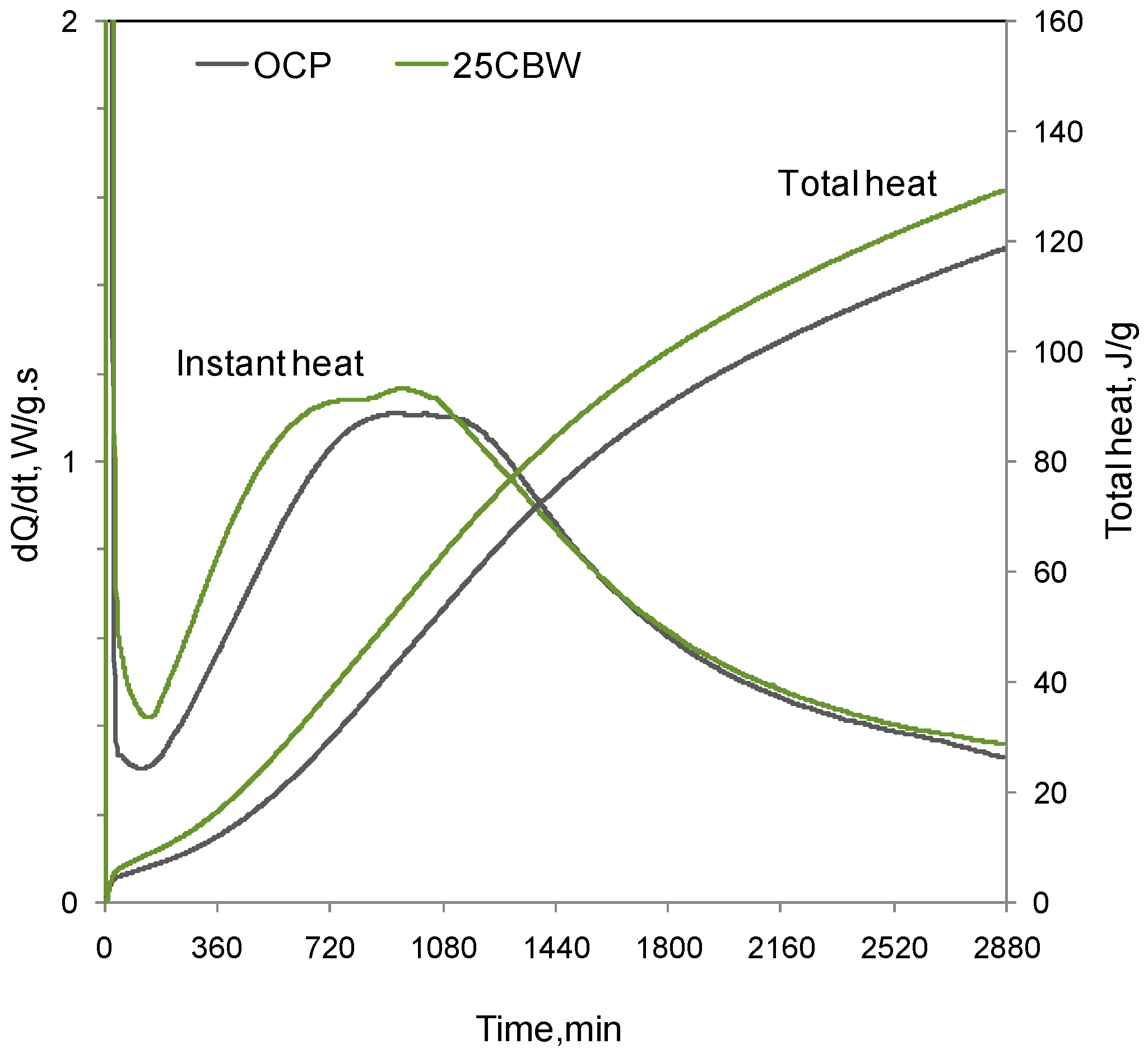
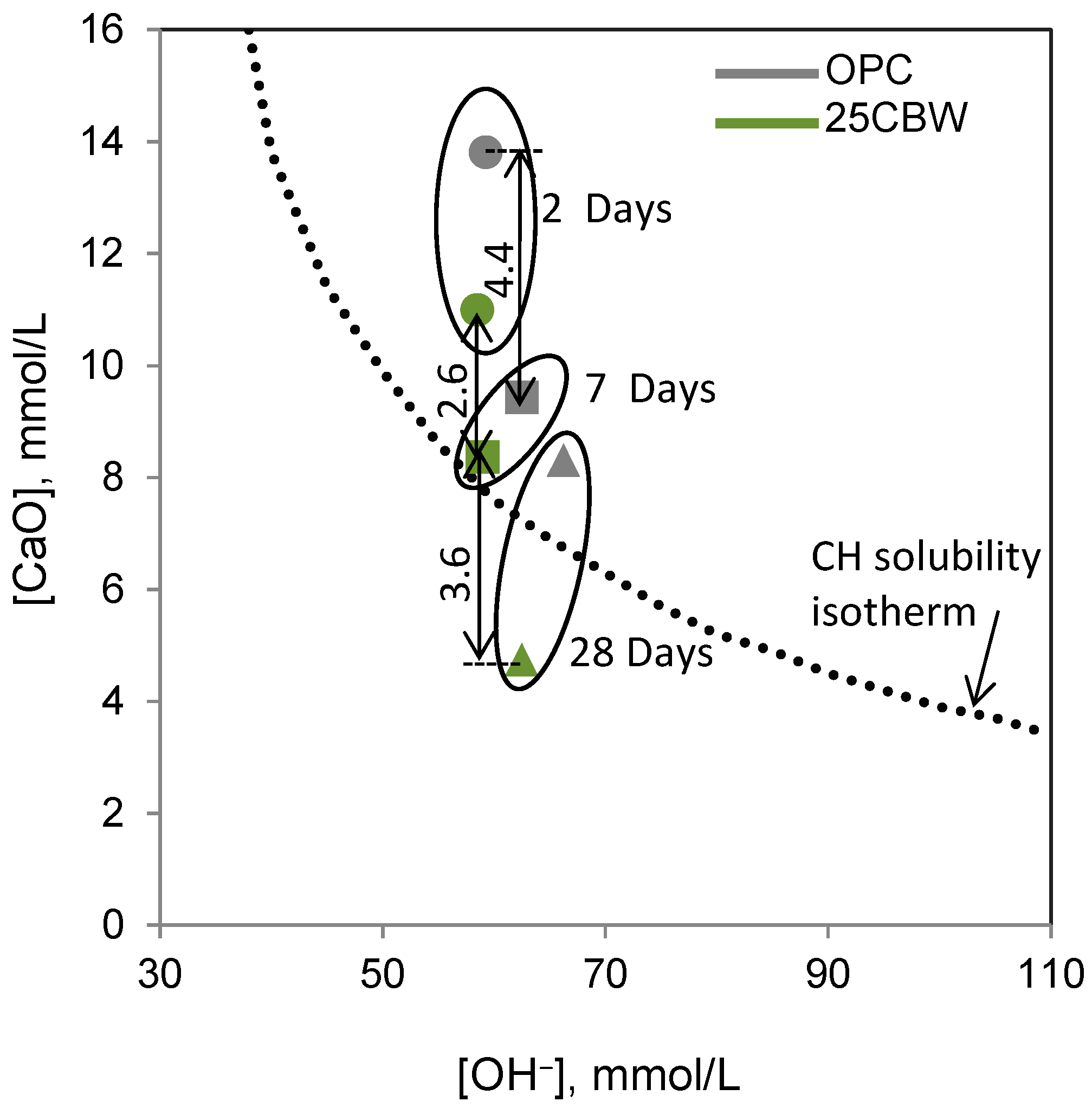

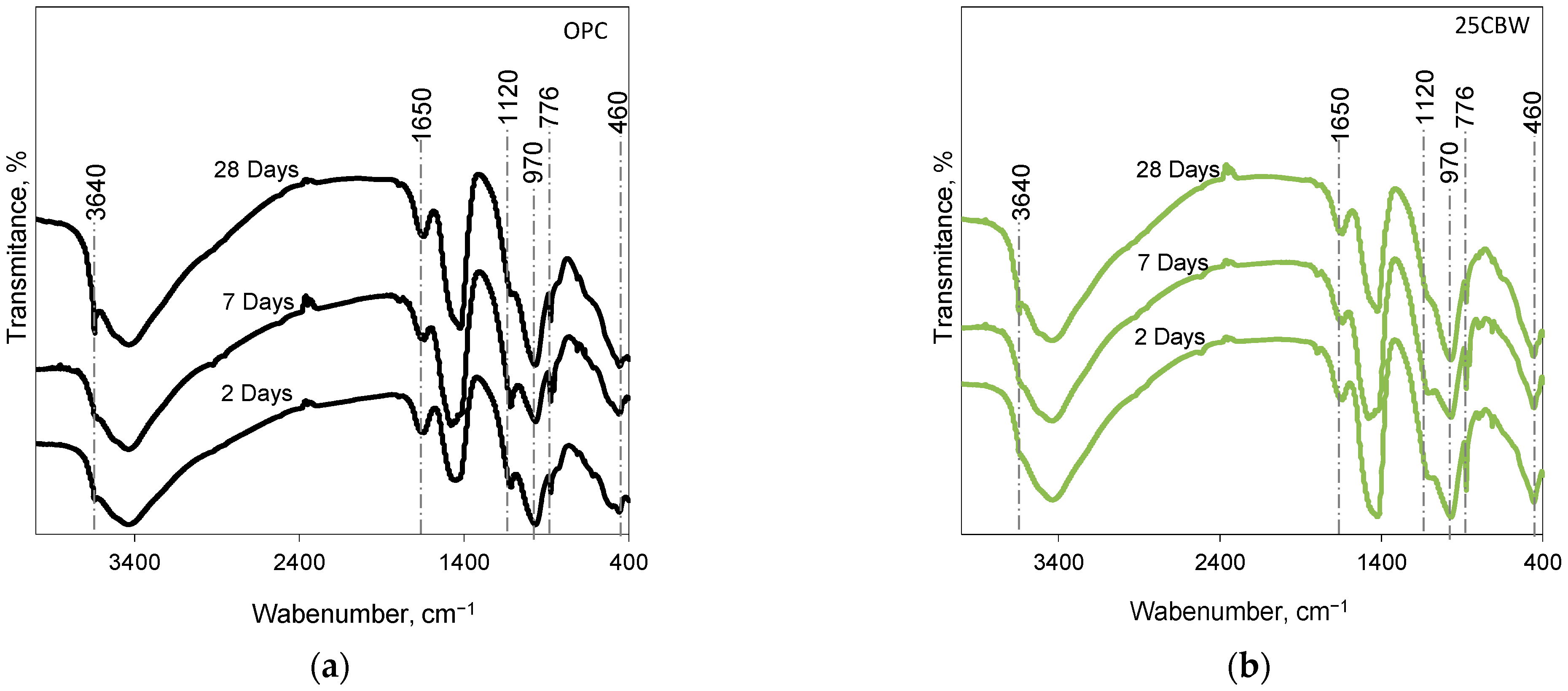



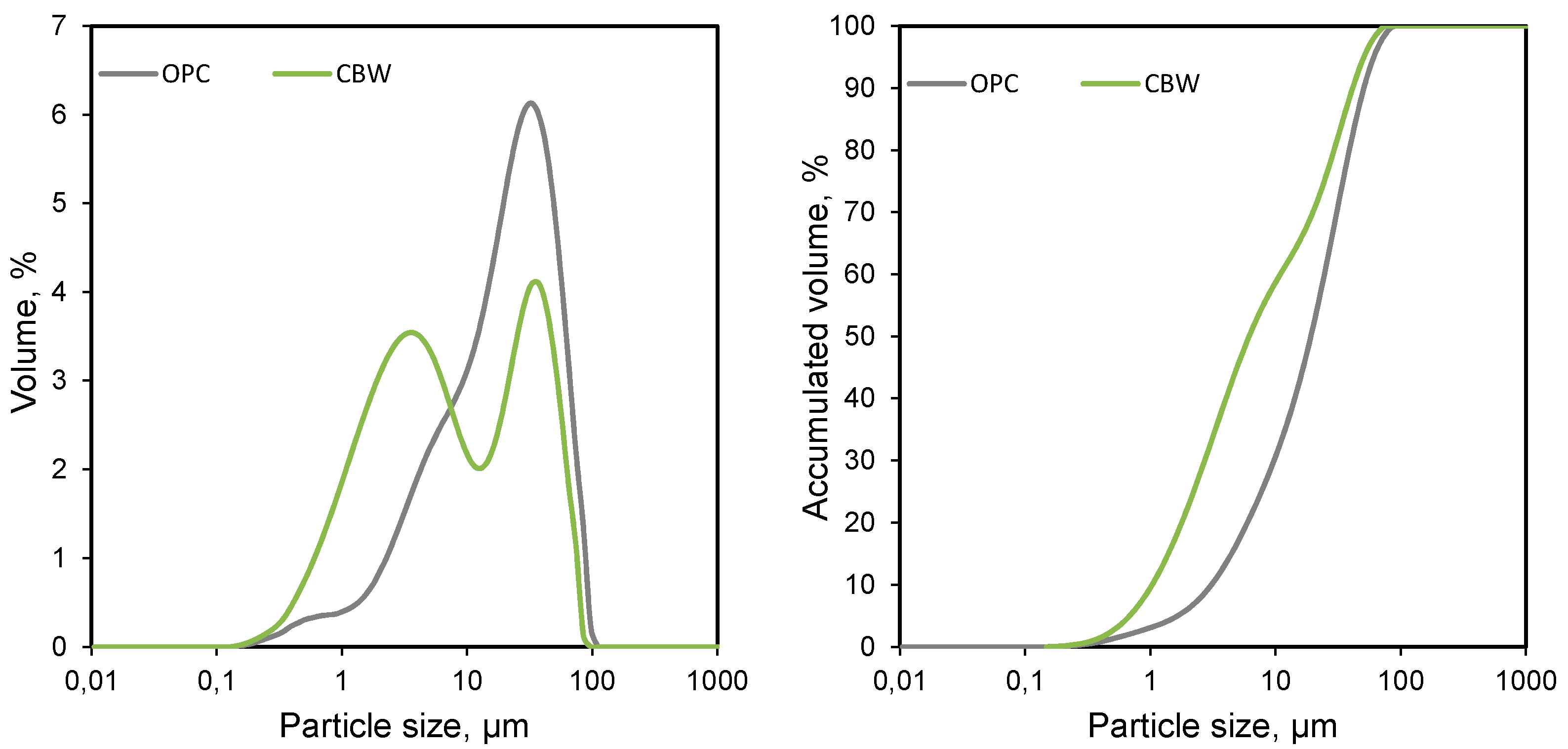
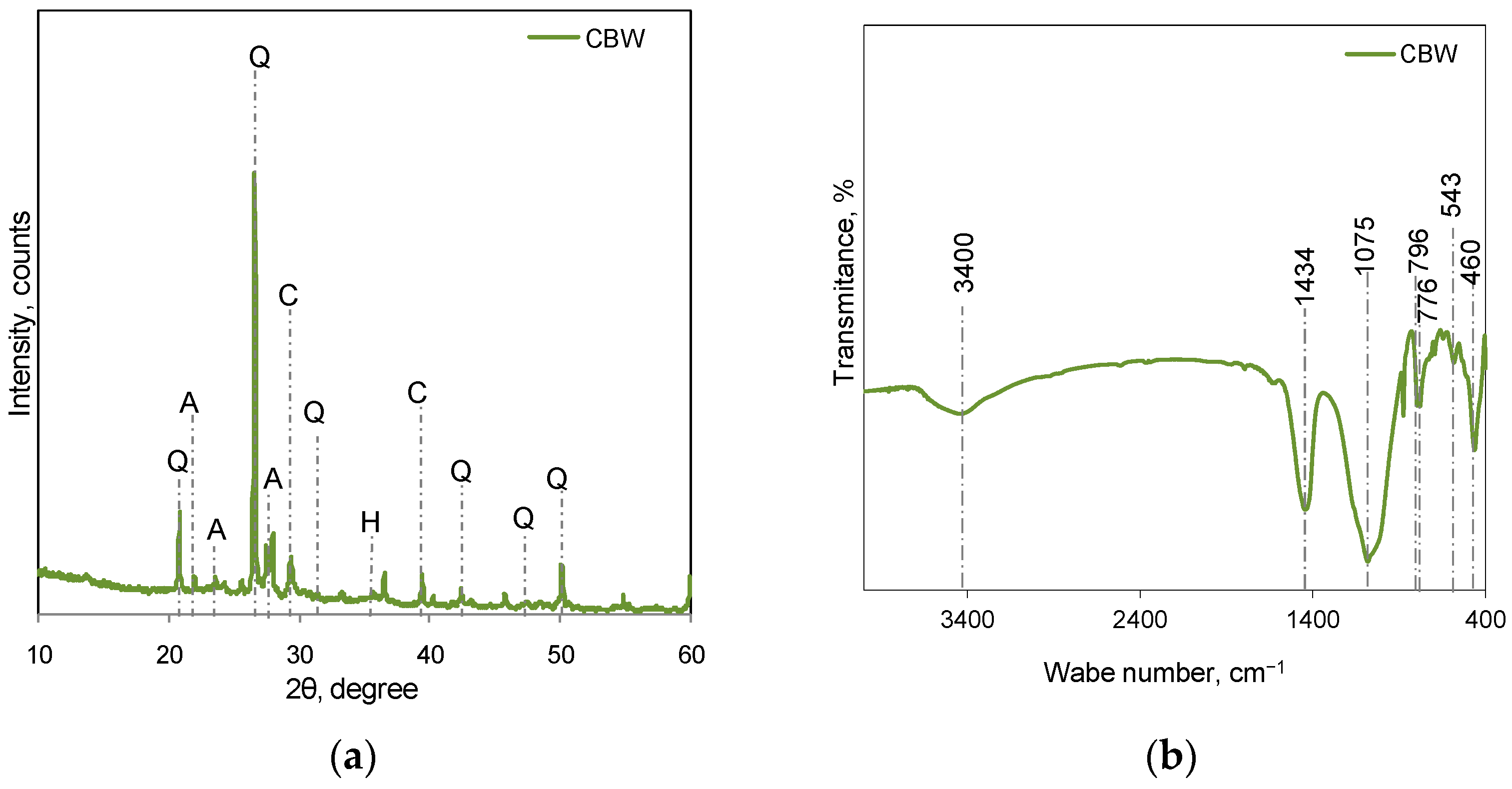
| Paper | Type of Ceramic Waste Used | % Replacement | Tests Performed | Main Findings |
|---|---|---|---|---|
| [17] | Ceramic block, mud-brick, and sanitary ware from the ceramic industry | 24 | Frattini test, XRD, FTIR, and non-evaporable water content. Chloride penetration, sulfate attack, and ASR. | All CWs show pozzolanic activity at 28 days, reduce the apparent chloride diffusion coefficient, perform well against the sulfate attack, and reduce the expansion caused by ASR. |
| [18] | Bricks powder generated from the ceramic industry. | 5, 10, 15, 20 | Physicochemical and mineralogical properties. Mechanical strengths and SEM for mortar. | Waste brick improves the grinding time and decreases the setting times. A 10% addition of CW increased mortar mechanical strengths at 90 days. Results confirmed the pozzolanic activity of CW. |
| [19] | Bricks powder generated from the ceramic industry. | 10, 15, 20, 25, 30, 40 | Pozzolanic properties. Compressive strength of concrete. | CW shows pozzolanic properties. Compressive strengths decrease with increasing CW content at early ages. CW < 20% slightly affects the strength. |
| [20] | Bricks powder generated from the ceramic industry | 10, 20, 30, 40, 50 | Compressive strength, toxicity characteristic of leaching, pozzolanic activity, XRD, and FTIR | Heavy metals leaching concentrations of waste brick were lower than the regulatory limits. At 28 days, the pozzolanic reaction began, reducing the amount of CH and increasing the densification. CW shows pozzolanic activity. |
| [21] | Ground calcined-clay brick. | 10, 20, 30, 40 | Stress–strain curves, pore size distribution, total porosity, sorptivity, and chloride penetration. | CW refined the pore structure and reduced macropores and total porosity. Reduction in modulus of elasticity and uniaxial compressive strength of mortars when the CW replacement was higher than 10%. |
| [22] | Glass, bricks, and tiles of red clay from the ceramic industry. | 10, 20, 25, 30, 40 | Mortar workability, mortar strength, and ASR. | CW replacements slightly decrease the fresh mortar consistency. From 28 to 90 days, compressive strength gain was higher for mortar with tile powders. SAI at 28 days > 0.75. Confirmation of the pozzolanic activity of CW, making their incorporation as cement mortars and concrete components feasible. |
| [23] | Ground clay roof tiles. | 10, 20 | Pozzolanic activity (lime consumption), compressive strength of mortar, and SEM. | CW has good pozzolanic properties; at an early age, the pozzolanic activity was higher than fly ash, although it was lower than silica fume. The morphologies of clay tile–PC pastes are similar to those of pastes containing other pozzolanic materials. |
| [24] | Sanitary ware from the ceramic industry and recycled fine aggregate from C&DW. | 10, 20 | Rheology and conduction calorimetry. | SW reduced shear yield stress and stunted the hydration reactions. C&DW had the opposite effect, raising yield stress and accelerating hydration kinetics. Cement particle hydration was modified depending on the type of CW: the reaction is accelerated by the inclusion of C&DW and stunted by SW. |
| [25] | Tile from the ceramic industry. | 20, 30 | SEM-EDX, XRD, and FTIR; laser granulometry, lime consumption, Fratini test, compressive strength, and the evolution of hydration (XRD and FTIR). | The compressive strength of blended cements was greater than 75% OPC at 28 days. CW < 30% does not significantly affect the compressive strength when the pozzolanic reaction contributes at later ages. |
| Wn, g/g | |||
|---|---|---|---|
| Pastes | 2 Days | 7 Days | 28 Days |
| OPC | 0.132 | 0.178 | 0.199 |
| 25CBW | 0.115 | 0.153 | 0.198 |
| Property | Concrete | ||
|---|---|---|---|
| OPC | 25CBW | ||
| Elastic modulus, GPa | 2 days | 25.8 | 21.8 |
| 7 days | 31.0 | 26.6 | |
| 28 days | 33.0 | 29.6 | |
| 90 days | 40.7 | 40.8 | |
| Initial rate of water absorption, S1 g/m2·s1/2 | 2 days | 45.0 | 24.8 |
| 7 days | 12.3 | 8.5 | |
| 28 days | 8.5 | 6.7 | |
| Sorptivity capacity, g/m2 | 2 days | 5583 | 5273 |
| 7 days | 4288 | 4218 | |
| 28 days | 4036 | 3518 | |
| Water penetration, mm | Average | 19.5 | 20.6 |
| Maximum | 26.0 | 31.7 | |
| Minimum | 12.0 | 9.0 | |
| Materials | OPC | CBW |
|---|---|---|
| Chemical composition, % by mass | ||
| SiO2 | 20.50 | 62.36 |
| Al2O3 | 4.10 | 12.03 |
| Fe2O3 | 4.70 | 4.19 |
| CaO | 63.60 | 8.36 |
| MgO | 0.70 | 0.93 |
| SO3 | 2.50 | 0.15 |
| K2O | 1.20 | 3.34 |
| Na2O | <0.03 | 1.44 |
| TiO2 | - | 0.56 |
| Loss on ignition | 2.40 | 6.01 |
| SiO2 + Al2O3+ Fe2O3 | 74.39 | |
| Equivalent alkalis (Na2O + 0.658 K2O), % | 3.63 | |
| Physical properties | ||
| Density, g/cm3 | 3.12 | 2.58 |
| SEB, m2/kg | 370 | 660 |
| Particle size distribution μm | ||
| D10 | 3.30 | 1.11 |
| D50 | 20.51 | 6.58 |
| D90 | 86.36 | 44.23 |
Disclaimer/Publisher’s Note: The statements, opinions and data contained in all publications are solely those of the individual author(s) and contributor(s) and not of MDPI and/or the editor(s). MDPI and/or the editor(s) disclaim responsibility for any injury to people or property resulting from any ideas, methods, instructions or products referred to in the content. |
© 2023 by the authors. Licensee MDPI, Basel, Switzerland. This article is an open access article distributed under the terms and conditions of the Creative Commons Attribution (CC BY) license (https://creativecommons.org/licenses/by/4.0/).
Share and Cite
Zito, S.V.; Irassar, E.F.; Rahhal, V.F. Recycled Construction and Demolition Waste as Supplementary Cementing Materials in Eco-Friendly Concrete. Recycling 2023, 8, 54. https://doi.org/10.3390/recycling8040054
Zito SV, Irassar EF, Rahhal VF. Recycled Construction and Demolition Waste as Supplementary Cementing Materials in Eco-Friendly Concrete. Recycling. 2023; 8(4):54. https://doi.org/10.3390/recycling8040054
Chicago/Turabian StyleZito, Silvina V., Edgardo F. Irassar, and Viviana F. Rahhal. 2023. "Recycled Construction and Demolition Waste as Supplementary Cementing Materials in Eco-Friendly Concrete" Recycling 8, no. 4: 54. https://doi.org/10.3390/recycling8040054
APA StyleZito, S. V., Irassar, E. F., & Rahhal, V. F. (2023). Recycled Construction and Demolition Waste as Supplementary Cementing Materials in Eco-Friendly Concrete. Recycling, 8(4), 54. https://doi.org/10.3390/recycling8040054






